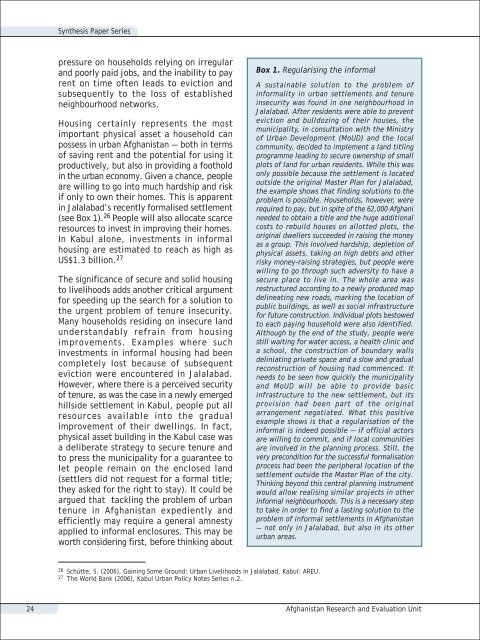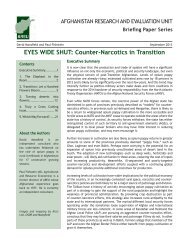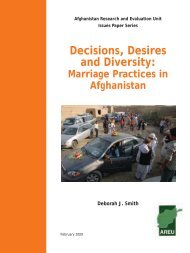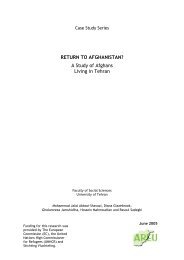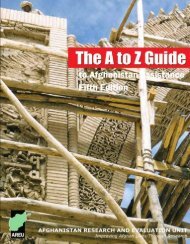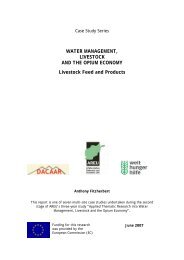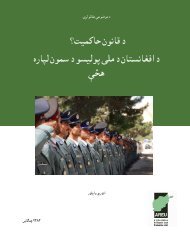Urban Livelihoods in Afghanistan - the Afghanistan Research and ...
Urban Livelihoods in Afghanistan - the Afghanistan Research and ...
Urban Livelihoods in Afghanistan - the Afghanistan Research and ...
You also want an ePaper? Increase the reach of your titles
YUMPU automatically turns print PDFs into web optimized ePapers that Google loves.
Syn<strong>the</strong>sis Paper Seriespressure on households rely<strong>in</strong>g on irregular<strong>and</strong> poorly paid jobs, <strong>and</strong> <strong>the</strong> <strong>in</strong>ability to payrent on time often leads to eviction <strong>and</strong>subsequently to <strong>the</strong> loss of establishedneighbourhood networks.Hous<strong>in</strong>g certa<strong>in</strong>ly represents <strong>the</strong> mostimportant physical asset a household canpossess <strong>in</strong> urban <strong>Afghanistan</strong> — both <strong>in</strong> termsof sav<strong>in</strong>g rent <strong>and</strong> <strong>the</strong> potential for us<strong>in</strong>g itproductively, but also <strong>in</strong> provid<strong>in</strong>g a foothold<strong>in</strong> <strong>the</strong> urban economy. Given a chance, peopleare will<strong>in</strong>g to go <strong>in</strong>to much hardship <strong>and</strong> riskif only to own <strong>the</strong>ir homes. This is apparent<strong>in</strong> Jalalabad’s recently formalised settlement(see Box 1). 26 People will also allocate scarceresources to <strong>in</strong>vest <strong>in</strong> improv<strong>in</strong>g <strong>the</strong>ir homes.In Kabul alone, <strong>in</strong>vestments <strong>in</strong> <strong>in</strong>formalhous<strong>in</strong>g are estimated to reach as high asUS$1.3 billion. 27The significance of secure <strong>and</strong> solid hous<strong>in</strong>gto livelihoods adds ano<strong>the</strong>r critical argumentfor speed<strong>in</strong>g up <strong>the</strong> search for a solution to<strong>the</strong> urgent problem of tenure <strong>in</strong>security.Many households resid<strong>in</strong>g on <strong>in</strong>secure l<strong>and</strong>underst<strong>and</strong>ably refra<strong>in</strong> from hous<strong>in</strong>gimprovements. Examples where such<strong>in</strong>vestments <strong>in</strong> <strong>in</strong>formal hous<strong>in</strong>g had beencompletely lost because of subsequenteviction were encountered <strong>in</strong> Jalalabad.However, where <strong>the</strong>re is a perceived securityof tenure, as was <strong>the</strong> case <strong>in</strong> a newly emergedhillside settlement <strong>in</strong> Kabul, people put allresources available <strong>in</strong>to <strong>the</strong> gradualimprovement of <strong>the</strong>ir dwell<strong>in</strong>gs. In fact,physical asset build<strong>in</strong>g <strong>in</strong> <strong>the</strong> Kabul case wasa deliberate strategy to secure tenure <strong>and</strong>to press <strong>the</strong> municipality for a guarantee tolet people rema<strong>in</strong> on <strong>the</strong> enclosed l<strong>and</strong>(settlers did not request for a formal title;<strong>the</strong>y asked for <strong>the</strong> right to stay). It could beargued that tackl<strong>in</strong>g <strong>the</strong> problem of urbantenure <strong>in</strong> <strong>Afghanistan</strong> expediently <strong>and</strong>efficiently may require a general amnestyapplied to <strong>in</strong>formal enclosures. This may beworth consider<strong>in</strong>g first, before th<strong>in</strong>k<strong>in</strong>g aboutBox 1. Regularis<strong>in</strong>g <strong>the</strong> <strong>in</strong>formalA susta<strong>in</strong>able solution to <strong>the</strong> problem of<strong>in</strong>formality <strong>in</strong> urban settlements <strong>and</strong> tenure<strong>in</strong>security was found <strong>in</strong> one neighbourhood <strong>in</strong>Jalalabad. After residents were able to preventeviction <strong>and</strong> bulldoz<strong>in</strong>g of <strong>the</strong>ir houses, <strong>the</strong>municipality, <strong>in</strong> consultation with <strong>the</strong> M<strong>in</strong>istryof <strong>Urban</strong> Development (MoUD) <strong>and</strong> <strong>the</strong> localcommunity, decided to implement a l<strong>and</strong> titl<strong>in</strong>gprogramme lead<strong>in</strong>g to secure ownership of smallplots of l<strong>and</strong> for urban residents. While this wasonly possible because <strong>the</strong> settlement is locatedoutside <strong>the</strong> orig<strong>in</strong>al Master Plan for Jalalabad,<strong>the</strong> example shows that f<strong>in</strong>d<strong>in</strong>g solutions to <strong>the</strong>problem is possible. Households, however, wererequired to pay, but <strong>in</strong> spite of <strong>the</strong> 62,000 Afghan<strong>in</strong>eeded to obta<strong>in</strong> a title <strong>and</strong> <strong>the</strong> huge additionalcosts to rebuild houses on allotted plots, <strong>the</strong>orig<strong>in</strong>al dwellers succeeded <strong>in</strong> rais<strong>in</strong>g <strong>the</strong> moneyas a group. This <strong>in</strong>volved hardship, depletion ofphysical assets, tak<strong>in</strong>g on high debts <strong>and</strong> o<strong>the</strong>rrisky money-rais<strong>in</strong>g strategies, but people werewill<strong>in</strong>g to go through such adversity to have asecure place to live <strong>in</strong>. The whole area wasrestructured accord<strong>in</strong>g to a newly produced mapdel<strong>in</strong>eat<strong>in</strong>g new roads, mark<strong>in</strong>g <strong>the</strong> location ofpublic build<strong>in</strong>gs, as well as social <strong>in</strong>frastructurefor future construction. Individual plots bestowedto each pay<strong>in</strong>g household were also identified.Although by <strong>the</strong> end of <strong>the</strong> study, people werestill wait<strong>in</strong>g for water access, a health cl<strong>in</strong>ic <strong>and</strong>a school, <strong>the</strong> construction of boundary wallsdel<strong>in</strong>iat<strong>in</strong>g private space <strong>and</strong> a slow <strong>and</strong> gradualreconstruction of hous<strong>in</strong>g had commenced. Itneeds to be seen how quickly <strong>the</strong> municipality<strong>and</strong> MoUD will be able to provide basic<strong>in</strong>frastructure to <strong>the</strong> new settlement, but itsprovision had been part of <strong>the</strong> orig<strong>in</strong>alarrangement negotiated. What this positiveexample shows is that a regularisation of <strong>the</strong><strong>in</strong>formal is <strong>in</strong>deed possible — if official actorsare will<strong>in</strong>g to commit, <strong>and</strong> if local communitiesare <strong>in</strong>volved <strong>in</strong> <strong>the</strong> plann<strong>in</strong>g process. Still, <strong>the</strong>very precondition for <strong>the</strong> successful formalisationprocess had been <strong>the</strong> peripheral location of <strong>the</strong>settlement outside <strong>the</strong> Master Plan of <strong>the</strong> city.Th<strong>in</strong>k<strong>in</strong>g beyond this central plann<strong>in</strong>g <strong>in</strong>strumentwould allow realis<strong>in</strong>g similar projects <strong>in</strong> o<strong>the</strong>r<strong>in</strong>formal neighbourhoods. This is a necessary stepto take <strong>in</strong> order to f<strong>in</strong>d a last<strong>in</strong>g solution to <strong>the</strong>problem of <strong>in</strong>formal settlements <strong>in</strong> <strong>Afghanistan</strong>— not only <strong>in</strong> Jalalabad, but also <strong>in</strong> its o<strong>the</strong>rurban areas.26 Schütte, S. (2006), Ga<strong>in</strong><strong>in</strong>g Some Ground: <strong>Urban</strong> <strong>Livelihoods</strong> <strong>in</strong> Jalalabad, Kabul: AREU.27 The World Bank (2006), Kabul <strong>Urban</strong> Policy Notes Series n.2.24<strong>Afghanistan</strong> <strong>Research</strong> <strong>and</strong> Evaluation Unit


